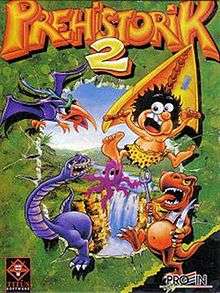Prehistorik 2
Prehistorik 2 is a platform game, the sequel to Prehistorik. It was developed by Titus Interactive for MS-DOS and Amstrad CPC in 1993.
| Prehistorik 2 | |
|---|---|
 | |
| Developer(s) | Titus France |
| Publisher(s) | Titus France |
| Designer(s) | Eric Zmiro |
| Composer(s) | Thorsten Mitschele (Game Boy) |
| Platform(s) | Amstrad CPC, MS-DOS |
| Release | 1993 |
| Genre(s) | Platform |
| Mode(s) | Single player |
Like in its predecessor, the main character of Prehistorik 2 is a caveman who goes in quest for food, fighting various animals[1] and humorous end of level bosses.
The game is a simple platform game where the player walks and jumps their way through the levels and whacks enemies in the head with a club. Points can be collected by both whacking enemies and collecting items (including food, diamonds, video games, etc.).[2] The levels contain hidden food items which can be discovered by hitting the right spots with the club.
The creators added a lot of detail to the game, which indeed increases the entertainment factor. If the player runs for a long distance and then stops, the caveman will be out of breath.
Controlling the game is very simple, with only the four arrow keys for movement and the space bar as an attack button.
Instead of having to collect at least the right amount of food to be able to reach the next level as in Prehistorik, in Prehistorik 2 it is only required to get a lighter before the player can go to the next level. All in all, there are ten levels plus three bonus levels.
There are various hidden secrets in this game, one shows some extra credits, and there is a collection of holiday photographs of the development team.[3]
Legacy
From 1996 and onwards, a notice stating that the game still works in the year it is played in appears when starting the EXE file.
Level codes differ on every machine with a different BIOS. For example, if Prehistorik 2 is played via DOSBox, the codes obtained are different than those when playing in Windows XP.
Prehistorik Man
The game was later ported to the Game Boy as Prehistorik Man.
A separate game, also titled Prehistorik Man, was released for the Super Nintendo Entertainment System.[4] The Super NES game was in turn ported to the Game Boy Advance and the Nintendo DSi (as a DSiWare release), with the latter being released in North America on February 15, 2010.
On release, Electronic Gaming Monthly gave the Game Boy version a 6 out of 10, commenting that "The whole game becomes monotonous as it gets tired somewhat quickly."[5] They rated the later Super NES version much better, giving it an 8.875 out of 10 and their "Game of the Month" award. They particularly lauded the game's storyline, humorous sound effects, strong play control, and numerous secrets.[6] Famicom Tsūshin scored the Super Famicom version of Prehistorik Man a 27 out of 40.[7]
See also
References
- Martin Milichovský (November 2005). "Prehistorik 2 - nepřátelé". Archived from the original on 22 March 2012. Retrieved 9 April 2011.
- Martin Milichovský (November 2005). "Prehistorik 2 - věci a objekty". Archived from the original on 22 March 2012. Retrieved 9 April 2011.
- Joseph Themay (December 2011). "Hollyday in Meyrues! Some weird holiday pictures are shown when you finish Prehistorik 2!". Archived from the original on 3 March 2016. Retrieved 19 December 2011.
- "Prehistorik Man - Release data". GameFAQs.
- "Review Crew: Prehistorik Man". Electronic Gaming Monthly. Ziff Davis (66): 46. January 1995.
- "Review Crew: Prehistorik Man". Electronic Gaming Monthly. Ziff Davis (70): 32. May 1995.
- NEW GAMES CROSS REVIEW: P-マン. Weekly Famicom Tsūshin. No.341. Pg.30. 30 June 1995.